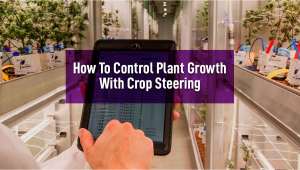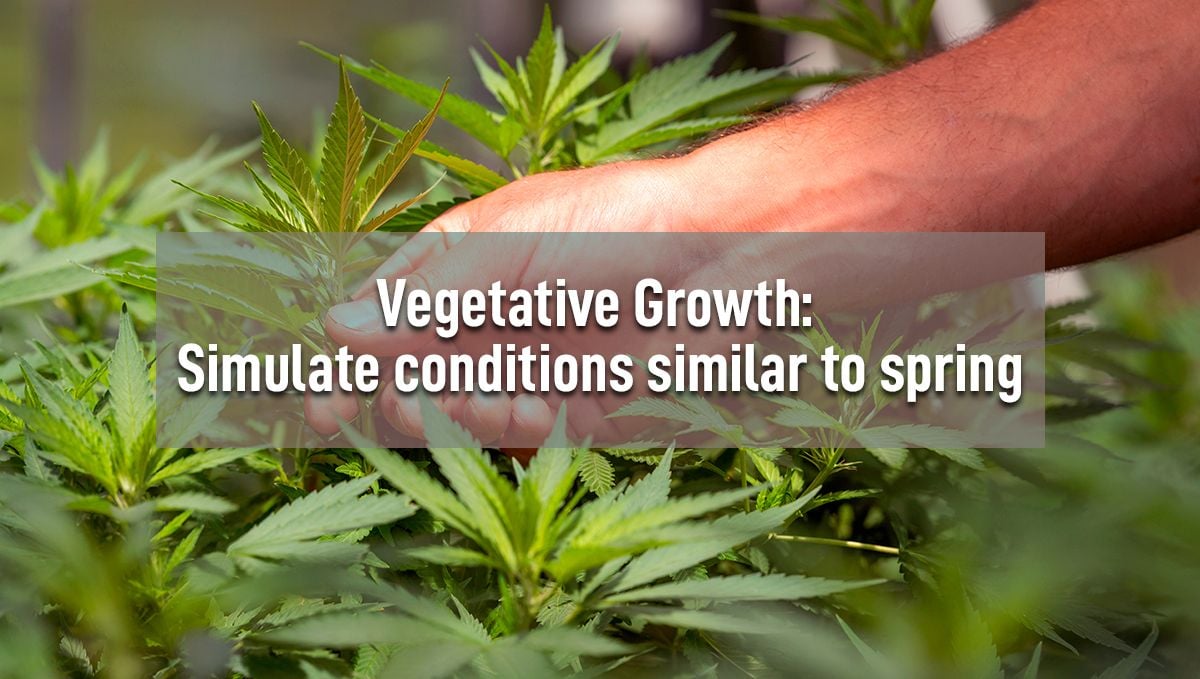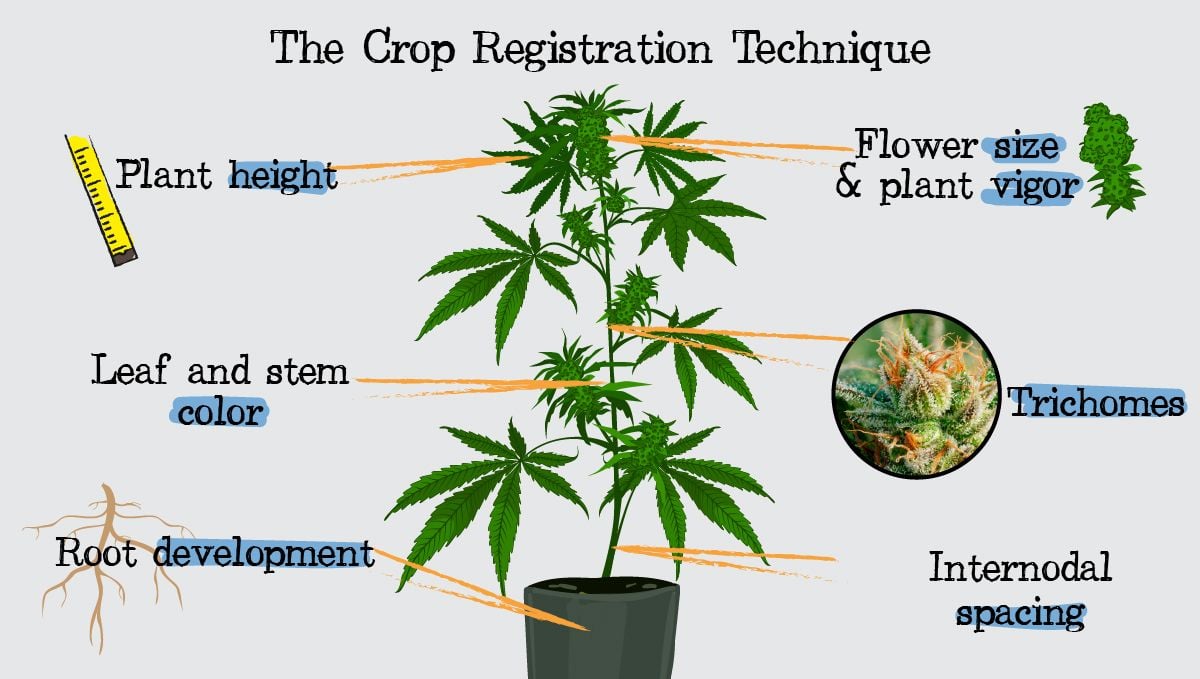How To Regulate Cannabis Growth With Crop Steering

- 1. What is crop steering?
- 1. a. Plant growth balance
- 2. The vegetative stage
- 2. a. Crop steering in the vegetative stage
- 3. The flowering stage
- 3. a. Crop steering in the flowering stage
- 4. How to know if crop steering is working?
- 5. Other methods to steer plant growth and development
- 6. In conclusion
Crop steering techniques have been used for years and years with feminized seeds but due to the recent legalization, cannabis has become one of the most lucrative businesses in the world, this is why companies are looking to grow more efficiently, thus increasing profits and at the same time improving product quality. And this is where this technique comes in. Crop steering consists of adjusting the growing conditions in order to reach certain outcomes in the vegetative and flowering stages of cannabis.
1. What Is Crop Steering?
Crop steering refers to the ability to adjust the temperature, humidity, and irrigation to steer your plants to the desired outcome. This occurs because plants have certain hormones that regulate growth in response to the growing conditions and stresses, these reactions are related to the seasonal changes plants are accustomed to in nature. So, crop steering basically uses these hormonal responses by manipulating the environment to achieve the desired outcomes during the vegetative and flowering stages.
This means that crop steering can be used at any stage of plant growth in order to achieve specific goals you might have. In the last couple of years, crop steering has become extremely popular in cannabis grow facilities as cultivators continue exploring the best methods to balance vegetative and generative plant growth when growing cannabis plants. With this method, cultivators can use generative steering to start the flowering stage with the change to 12/12.
Once the buds are fairly formed, cultivators will then switch back to vegetative steering after the first defoliation in order to keep the plant healthy and improve bud fattening. In most cases, cultivators go back and forth between generative and vegetative steering techniques to maintain good plant balance. Cultivators often maintain vegetative steering methods until a couple of weeks before harvest, when they then switch to a heavy steering technique to finish ripening. It’s highly recommended you experiment with all crop steering methods to see how a certain strain or plant will react.
Plant Growth Balance
Plants in the growth stage are in a state where the majority of the energy is directed towards leaf and branch growth but very little towards flower production while plants in the flowering stage direct the majority of the energy towards flower production and very little towards leaf or branch growth.

This is why cultivators must keep proper plant growth balance between leaf, branch, and flower production; When talking about cannabis, plants that are growing too bushy or those that grow too much bud with very little leaves (which can slow down photosynthesis) are considered to be out of balance and if the plant is out of balance, it can end up affecting bud production and quality of the harvest. So the best way to improve overall plant growth is to optimize vegetative growth, ensuring the plants only produce enough leaves and branches to be able to support big, dense flowers without spending too many resources developing extra plant matter.
2. The Vegetative Stage
The vegetative stage is when cannabis plants develop the stem, branches, and foliage which, in this stage, are the predominant focus of the plant’s energy. As the plants grow, the increase in green matter results in an increase in photosynthesis capacity which helps prepare the plant for the flowering stage.

Despite the vegetative being when cannabis plants usually develop the foliage and branches you can stimulate green matter growth ( such as leaves, stems, and branches) also during the flowering stage.
So, for example, if you have a plant in the flowering stage that’s growing slowly or too compact, you can help it stretch out and increase internode spacing with the crop steering technique.
Crop Steering In The Vegetative Stage
In order to stimulate green matter growth (not reveg a flowering plant but increase branch and leaf growth), you need to simulate conditions similar to spring, allowing your plant to grow green matter more vigorously. The climate conditions include:
- Lower VPD;
- Lower Light Intensity;
- And a stress-free environment.
In order to help you visualize these conditions, here’s a vegetative growth climate crop steering chart:
Climate Steering For Vegetative Growth
| Temperature | 25 - 31°C |
|---|---|
| Humidity | 65 - 80% |
| Vapor Pressure Deficit (VPD) | 0.8 - 1.1 kPa |
| CO2 | 500 - 800 ppm |
| Day/Night Temp. Difference | 0 - 12°C |
Vapor Pressure Deficit (VPD)
VPD is the difference between the amount of moisture in the air and how much moisture the air can hold. This is very important because, as the VPD increases, the plant needs to absorb more water from its roots.
Apart from the climate conditions, there are also some irrigation conditions needed, which include:
- Higher water content;
- And Lower EC.
Irrigation Steering For Vegetative Growth
| Shot Size | 1 - 3% of substrate volume |
|---|---|
| Dry Back | 10 - 15% |
| Substrate Temperature | 22 - 25°C |
| Electrical Conductivity (EC) | 2 - 4 dS/m |
| Water Content | 55 - 70% |
| Irrigation Frequency | 6 - 9+ when lights are on |
Shot Size
The amount of water used to irrigate your crop, it's the amount of water you should water within every watering.
Dry Back
The difference between water content in the substrate from the last irrigation to the next irrigation. Basically how dry the substrate gets between waterings.
Electrical Conductivity (EC)
A measurement of how well water can transport an electric charge which is proportional to the amount of fertilizer in the nutrient solution.
Just remember that these are examples of the conditions that could promote green matter growth and the specific conditions will depend on the strain. It’s vital that you adjust the conditions and irrigation to your grow operation by experimenting with this technique and finding the sweet spot for the genetics you’re growing.
4. The Flowering Stage
During the flowering stage, the plant’s energy is focused on developing flowers and the plants slow down the growth of new leaves, branches, and reduce stretching.

Now, just as mentioned before, if you feel like your plants are not developing enough leaves to support flower growth or you want more internodal spacing, for example, you can adjust the conditions in order to stimulate flower production.
Crop Steering In The Flowering Stage
In order to apply this technique to the flowering stage you need to simulate summer-like conditions, the flowering climate conditions include:
- Higher VPD
- And Higher light intensity.
Climate Steering For Flowering Growth
| Temperature | 15 - 25°C |
|---|---|
| Humidity | 40 - 70% |
| Vapor Pressure Deficit (VPD) | 1.0 - 1.5 kPa |
| CO2 | 800 - 1200 ppm |
| Day/Night Temp. Difference | 0 - 12°C |
Apart from the climate conditions, there are also some irrigation conditions needed, which include:
- Lower water content;
- And Higher EC;
Irrigation Steering For Flowering Growth
| Shot Size | 4-8% of substrate volume |
|---|---|
| Dry Back | 15 - 30%+ |
| Substrate Temperature | 20 - 24°C |
| Electrical Conductivity (EC) | 5 - 12 dS/m |
| Water Content | 25 - 70% |
| Irrigation Frequency | 3 - 9+ when lights are on |
Keep in mind that these are just examples of the conditions that could promote flower growth and the specific conditions will depend on the strain. It’s vital that you adjust the conditions and irrigation to your grow operation by experimenting with this technique and finding the sweet spot for the genetics you’re growing.
5. How To Know If Crop Steering Is Working?
In order for you to know if this technique is working, it’s essential you keep track of every plant, which is known as crop registration. Crop registration basically works by keeping detailed observations about your plants, probably being the most important aspect of this technique.
By keeping a record you can track how your plants react to the different changes in the environment and irrigation, allowing you to find the sweet spot for each genetic you’re growing.

So, what should you keep track of? Well, this will depend on what characteristics you’re looking to improve but, in general, the most common observations are:
- Plant height;
- Root development;
- Stem diameter;
- Internodal spacing;
- Leaf and stem color;
- Trichomes;
- Plant vigor;
- And the size of the flowers.
By Keeping track of these characteristics after each grow cycle you can begin to understand how the different growing conditions and irrigation methods can affect each specific strain. This database can become a powerful tool for you to optimize yields and overall plant growth, allowing you to know exactly what to adjust for each specific genetic in order to get the best results possible.
6. Other Methods to Steer Plant Growth and Development
While crop steering is a super effective way to control and optimize the development and final yield of your cannabis crop, it is anything but the only method available to cultivators. And it is a pretty advanced and involved way of running a grow area. For the novices and hobbyists out there, taking control of the growing environment to this degree is almost unattainable - especially if you are growing outdoors.
If you are looking for other methods that can help boost plant structure and robustness, increase flower production and potency, and ensure your crop is as successful as possible, then you have a lot of options.
Stress Training
Stress training is split into two main groups, High-Stress Training (HST) and Low-Stress Training (LST). These methods work on the principle that inducing stress or even injury on the plant will force it to create new growth and increase its yield. This can be done in two ways: by causing physical stress on the plant, or by controlling the way that the plant grows.
HST Methods
Hight-stress training techniques cover a huge range of methods, from pruning and topping to bending and super cropping - and way more. The general idea is that you are subjecting the plant to such a level of stress that it will be forced to create new growth points, increase flower production and become more vigorous.
- Topping involves removing the crown to force the plant to grow two main stems instead of one, and this process can be repeated multiple times. This not only increases the number of budding sites but also promotes much more lateral growth.
- Super cropping is similar in the way that it induces stress on the plant, however instead of removing the apex or crown, you are applying pressure to bend a branch and then tying it in place. This will cause injury to the branch, but when healed it will be much stronger and able to support more flowers.
- The main lining is a method of inducing stress by creating multiple main stems. This is done by splitting one large stem into a few smaller ones and then tying them down horizontally to create even more lateral growth. This will allow for even more bud sites and a much larger harvest.
We do not recommend using HST methods with autoflowering strains unless you have a bunch of experience and a full understanding of the strain you are planning to use HST methods on.
LST Methods
Low-stress training methods are much less invasive and are more suited for autoflowering cultivars. This is due to the fact that autos simply do not have the time to bounce back from the more extreme methods of HST. LST is much gentler on your plants and is achieved by manipulating the branches at a more subtle and less dramatic level. This can be done through tucking, bending and tying down branches, or by controlling the way the canopy develops overall. The tie-down method involves tying down the branches and the main stem in order to encourage more lateral growth, which will lead to bigger buds.
By opening up the canopy, we allow a more even spread of light penetration throughout all of the budding sites. The Screen of Green (ScrOG) method is one of the most commonly used training techniques, no matter if you are growing autos or photos. This great technique involves using a screen or net to manipulate the canopy and spread out the individual flowering sites. This allows for more even light distribution and a much higher yield. No matter what method you decide to use, it is important to remember not to overdo it and stress your plants out too much, especially if you are growing autos.
Nutrient Management
The quality of the nutrients that you feed your plants is just as important as the training methods used. Giving your marijuana the right mix of nutrients will help to promote strong and healthy growth, as well as increase the overall yield of your plants. Organic fertilizers are ideal for marijuana cultivation due to their slow release of nutrients into the soil.
They are also much more gentle on your plants and will not cause any sudden drops or spikes in the pH levels. It is important to understand your plant’s nutritional requirements and to adjust accordingly throughout the growth cycle. If you are growing with regular soil, then you will need to supplement your plants with a suitable organic fertilizer every few weeks to ensure that they are getting all of the essential nutrients. In general, we suggest always buying cannabis-specific soil blends.
7. In Conclusion
Cannabis farming is not new. Cannabis is one of the first plants domesticated by us, humans and as legalization continues, more and more new techniques will start to come up. Cannabis crop steering methods are fairly new and still are in their early days so growers still need specific equipment in order to collect data and adjust parameters in order to perfect these techniques. Remember, when growing weed you’re always learning something new, and commercial growers will always want to put out the best product so cannabis crop steering will not only continue to get more and more sophisticated and optimized but will be an essential aspect in cannabis growing.
It can be hard to control all of the aspects mentioned without the right equipment but having all of these elements in mind can help you get better results even if you’re a home grower. Crop steering has been used for a long time but has recently been used in cannabis, showing excellent results. If you have experience with crop steering, feel free to help fellow growers by leaving a comment in the comment section below!
External References
Growers guide to crop steering - Trym
Chlorophyll b as a source of signals steering plant development - Tyutereva, Elena & Dmitrieva, Valeria & Voitsekhovskaja, Olga. (2017)
Plant management for generative or vegetative steering - Nederhoff, Elly & Houter, G.. (2009)









Comments